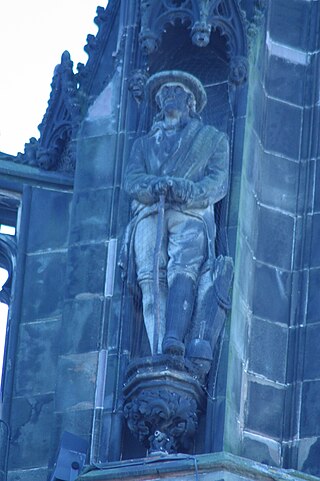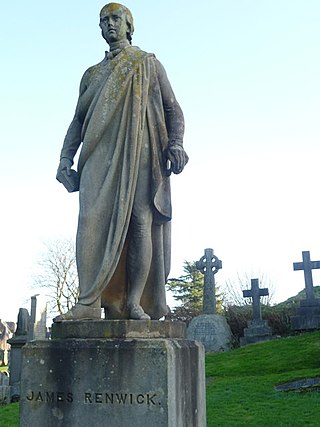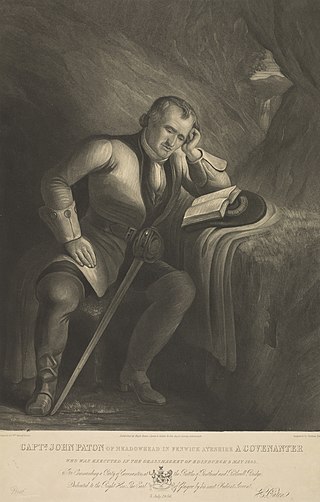
John Michael Welsh of Irongray was a leader of the Scottish Covenanter movement. Dunlop, an early 20th century writer, says: "It is a noteworthy fact that there exists no memoir of John Welsh of Irongray, though from the Battle of Rullion Green till Bothwell Bridge he was the most conspicuous Covenanting minister in Scotland. Had he glorified God in the Grassmarket, or fallen in some scuffle with Claverhouse's dragoons, or even like his friend Blackadder of Troqueer languished in prison on the Bass Rock, some pious hand would have been moved to write his story." Dunlop also wrote: "The events of Welsh's life must be sought for in the pages of Wodrow and Kirkton and in the letters and State papers of the reign of Charles II. After spending a fortnight hunting him in the British Museum, I have come to sympathise with Clavers and his dragoons. Mr John Welsh is a most elusive gentleman."

John Graham, 7th of Claverhouse, 1st Viscount Dundee was a Scottish soldier and nobleman, a Tory and an Episcopalian. He was responsible for policing southwest Scotland during and after the religious unrest and rebellion of the late 17th century, and went on to lead the Jacobite rising of 1689.

James Sharp, or Sharpe, was a minister in the Church of Scotland, or kirk, who served as Archbishop of St Andrews from 1661 to 1679. His support for Episcopalianism, or governance by bishops, brought him into conflict with elements of the kirk who advocated Presbyterianism. Twice the victim of assassination attempts, the second cost him his life.

Old Mortality is one of the Waverley novels by Walter Scott. Set in south west Scotland, it forms, along with The Black Dwarf, the 1st series of his Tales of My Landlord (1816). The novel deals with the period of the Covenanters, featuring their victory at Loudoun Hill and their defeat at Bothwell Bridge, both in June 1679; a final section is set in 1689 at the time of the royalist defeat at Killiecrankie.

The Killing Time was a period of conflict in Scottish history between the Presbyterian Covenanter movement, based largely in the southwest of the country, and the government forces of Kings Charles II and James VII. The period, roughly from 1679 to the Glorious Revolution of 1688, was subsequently called The Killing Time by Robert Wodrow in his The History of the Sufferings of the Church of Scotland from the Restoration to the Revolution, published in 1721–22. It is an important episode in the martyrology of the Church of Scotland.
Tillietudlem is a fictional castle in Walter Scott's 1816 novel Old Mortality, and a modern settlement in South Lanarkshire, Scotland.
William Craig Brownlee was an American clergyman, professor of languages and author. He was born in Lanarkshire, Scotland and was the fourth son of the Laird of Torfoot. President William McKinley was a distant cousin.

John Brown (1627–1685), also known as the Christian Carrier, was a Protestant Covenanter from Priesthill farm, a few miles from Muirkirk in Ayrshire, Scotland. He became a Presbyterian martyr in 1685.

The Battle of Bothwell Bridge, or Bothwell Brig' took place on 22 June 1679. It was fought between government troops and militant Presbyterian Covenanters, and signalled the end of their brief rebellion. The battle took place at the bridge over the River Clyde between Hamilton and Bothwell in Lanarkshire, Scotland. The battlefield has been included in the Inventory of Historic Battlefields in Scotland and protected by Historic Scotland under the Historic Environment (Amendment) Act 2011.

Covenanters were members of a 17th-century Scottish religious and political movement, who supported a Presbyterian Church of Scotland and the primacy of its leaders in religious affairs. The name is derived from covenant, a biblical term for a bond or agreement with God.

David Hackston or Halkerstone, was a militant Scottish Covenanter, remembered mainly for his part in the murder of Archbishop James Sharp of St. Andrews in 1679 and his involvement in the events of 1680 which led to his capture and execution.
Robert Hamilton (1650–1701), second baronet of Preston, was one of the leaders of the Scottish Covenanters. He was the son of Sir Thomas Hamilton, and brother of Sir William, first baronet of Preston. Hamilton was educated at Glasgow University under Professor Burnet. He attached himself to the cause of the Covenanters, and appears in command at Drumclog and Bothwell Brig. After the defeat he retired to Holland, where he remained with his brother-in-law, Gordon of Earlston, until the Revolution of 1688. He declined to recognise title of Prince of Orange, on the ground that he was not a Covenanted sovereign. He was arrested in Edinburgh for being concerned in the second Sanquhar Declaration of August, 1692, issued by the "United Societies". On liberation, he left his testimony afresh against backsliding in Church and State, and becomes as far as one person could be the main stay of "the afflicted Remnant." He died, unmarried, aged 51.

Drumclog is a small village in South Lanarkshire, Parish of Avendale and Drumclog, Scotland. The habitation is situated on the A71, between Caldermill and Priestland in East Ayrshire at a height of 196.7m and about 5 miles west of Strathaven.

Henry Hall was a Covenanter and Church of Scotland elder. He had firm Presbyterian convictions. He tried but was prevented from joining the Pentland Rising. He fought as an officer at Drumclog and at Bothwell Bridge. He was part of a group, along with Richard Cameron and Donald Cargill, who were openly opposed to the government's religious policies. Hall was intercepted at South Queensferry where Robert Middleton, the governor of Blackness Castle, tried to arrest him along with Donald Cargill. Hall managed to hold off the governor but received a mortal headwound from the butt of a gun from a taxman after Cargill had escaped. An unsigned and probably unfinished work known as The Queensferry Paper was found on Hall which caused considerable disquiet when it was read by government supporters.

John Paton was a Scottish soldier and Covenanter. He was executed at the Grassmarket on 9 May 1684 largely for his actions at the Battle of Bothwell Bridge.

John King was an outlawed minister of the Covenant, chaplain at one time to Lord Cardross, but seized by Claverhouse among the insurgents after the affair at Drumclog. King was taken to Edinburgh along with another preacher named John Kid. They were each subjected to torture, condemned to death, and executed. Following his death King's head and limbs were displayed at the Netherbow Port on Edinburgh's Royal Mile beside James Guthrie's skull.

John Kid was an outlawed minister of the Covenant. He was seized by Claverhouse among the insurgents after the affair at Drumclog. He was released by the insurgents but recaptured in a bog a few miles from Bothwell Bridge with a sword in his belt. Kid was taken to Edinburgh along with another preacher named John King. They were each subjected to torture, by the boots, condemned to death, and executed. Following his death Kid's head and limbs were displayed at the Netherbow Port on Edinburgh's Royal Mile beside James Guthrie's skull.

John Balfour of Kinloch was the principal actor in the assassination of Archbishop Sharp in 1679. For this crime his estate was forfeited and a large reward offered for his capture. He fought at Drumclog and at Bothwell Bridge, and is said to have escaped to Holland, and to have there tendered his services to the Prince of Orange.
Events from the year 1679 in the Kingdom of Scotland.
The Trumpeter's Well at Caldermill in South Lanarkshire is recorded as the site of the death of a government trumpeter or cornet who was killed in the aftermath of the 1679 Battle of Drumclog at which the Covenanters were victorious.





















